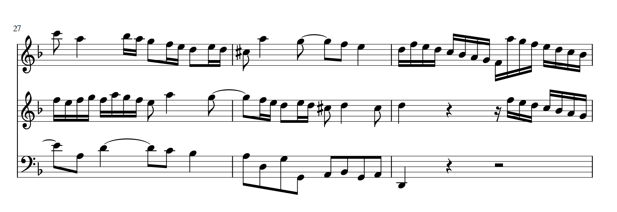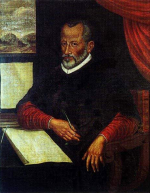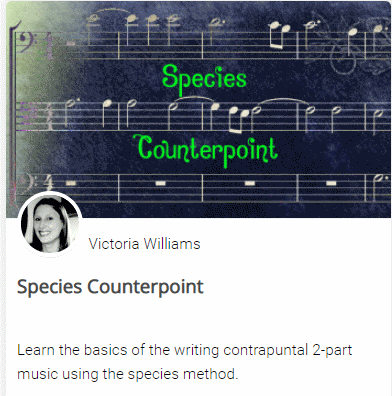Counterpoint in Music

Counterpoint Definition
Counterpoint is a style of musical writing which involves intertwining two or more melodies. Each individual melody (also called a “voice” or “part”) is an independent, musical idea, and the emphasis is on the separate strands of melody, on the horizontal axis, rather than on the harmony, or vertical axis.
This style of writing originated in the Renaissance era, and reached its apotheosis during Baroque times. Although its popularity lessened after the death of J.S. Bach, contrapuntal writing in music has continued to be important in all subsequent eras. All the Classical “Greats” such as Mozart, Haydn and Beethoven studied counterpoint in depth, and for many of these composers the use of counterpoint became increasingly signficant as they developed as composers. Both Mozart and Beethoven chose to employ more contrapuntal textures in their later music, than in their more youthful compositions.
Contrapuntal or Polyphonic?
Music which uses counterpoint is called either “contrapuntal” or “polyphonic”.The two terms are usually used fairly indiscriminately, although there is a fine distinction between their meanings. “Polyphonic” can refer more widely to a general style of writing and “contrapuntal” is often preferred when the focus is on the technical details, rather than the artistic effect. A large work like a movement from a symphony will usually not be totally “polyphonic” – that is, it will employ several different textures, and will be in part homophonic (a melody plus an accompaniment), and at times contrapuntal (using several simultaneous melodies).
Species Counterpoint

The polyphonic music of Palestrina (1525-1594) (pictured) was held in very high regard throughout the Renaissance and well into Baroque times. Several text books were written, trying to pinpoint how Palestrina crafted his counterpoint, so that others could emulate his wonderful style.
By the 18th century, the basics of counterpoint had been pared down to a beginner’s “step-by-step” method, which was eventually called “species counterpoint”, (“species” meaning “types”). This method was, and still is, seen as entry-level path towards writing larger, more complicated contrapuntal works.
The most famous text book on species counterpoint was “Gradus ad Parnassum” written by theorist Johann Fux in 1725.
There are five species, all of which deal with rhythm and dissonance/consonance in different ways. The fifth species is a combination of the first four.
If you would like to study species counterpoint, come and join the MyMusicTheory video course here:
Species Counterpoint Video Course

This video course will help you learn counterpoint in the traditional way – the same method that Mozart and Beethoven studied. The five counterpoint species are explained in an easy-to-follow, step-by-step way and you will also be able to download a PDF with species counterpoint exercises. It’s important to do plenty of species counterpoint practice in order to memorise all the rules – there are many, but once you have understood and applied them in practice, you will find your skills as a composer increase immensely. The book follows the basics of Fux’s counterpoint method. This course is suitable for anyone with an intermediate understanding of music theory.
Baroque and Early Classical Counterpoint
Baroque counterpoint is a much more complicated style than that of the earlier Renaissance.
At the time of Palestrina, music was written in modes – scales based on different patterns of tones and semitones than the major and minor scales we use today (with some overlaps). The modal system was gradually surpassed by the diatonic (major/minor) system, and by Baroque times most music was diatonic. This happened partly due to developments in tuning systems, which allowed keyboard instruments to be “in tune” regardless of which key the music was in, thanks to a system called “equal temperament”.
With equal temperament and the diatonic system, a new adventure became possible: modulation (key changes).
Advances in the way rhythm is notated also allowed composers to write complicated rhythms with great precision, and Baroque music is easily recognised for its “perpetual motion” feel.
During the Baroque era, the undisputed master of counterpoint was J.S. Bach. Bach wrote many types of contrapuntal composition, but his most intricate are his fugues. In Baroque counterpoint, new ways of manipulating the melody (in a mathematical way) were combined with artistic flair. Counterpoint was very much in fashion.
At the end of the Baroque era, trends were beginning to change, and the perpetual motion style gave way to a style based on short, tuneful phrases. Composers like Mozart, Beethoven, Schubert and others took elements from counterpoint, (and studied it in great detail), but used it in a different way to Bach – counterpoint became just one aspect of texture in a work, and it was much less likely to be used in a work as a whole. Contrapuntal sections were often contrasted with homophony (melody plus accompaniment), for example.
If you would like to join the MyMusicTheory video course on Practical Counterpoint, which covers the basics of counterpoint in the Baroque and early classical eras, sign up below!
Practical Counterpoint Video Course

This course takes a very brief look at species counterpoint, as a refresher, then focuses on the more practical aspect of writing counterpoint. The course will enable you to begin writing in a contrapuntal music style, first in 2-parts, and then expanding your skills to multiple parts and more complex structures such as the fugue or advanced techniques such as inverted counterpoint.
Watch the first video from the course below!